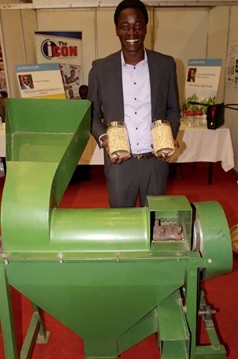
October 2017—About the size of a wheelbarrow, Stephen Ssekanyo’s “Kungula thresher” fits nicely on the back of a motorcycle. That means he can deliver it deep into rural areas where the unpaved roads become tracks and farmers rarely gain access to technologies. But by delivering his innovation to the farmers’ fields, he is helping them to prepare clean, ready-to-package maize at a price they can afford.
Common postharvest practices among rural farmers in Africa lead to 60 percent food loss. Smallerholder farmers in East Africa typically spend hours laboriously hand shelling or “stick beating”—the practice of repeatedly whacking a bag of maize cobs with a stick to remove the kernels.
Ssekanyo’s tool is reducing postharvest losses. Unlike many models of mechanized threshers, the Kungula thresher can handle cobs that have a high-moisture level, catering to the realities of smallholder farmers who do not have adequate cob storage to let the harvest dry, and cannot wait until the harvest dries for sale or consumption. High-moisture content makes the maize susceptible to mold growth and insect infestation, resulting in a high amount of broken grains and low milling yields.
The machine can thresh and winnow 1,000 kilograms of maize in one hour, using only a liter of fuel. The clean kernels fetch a higher price from millers and attract less moisture in storage.
The adoption of technologies like this across East Africa will help reduce postharvest loss in the region and consequently increase trade in agricultural commodities.
Feed the Future, the U.S. Government’s global hunger and food security initiative, works with its partners, through USAID, across the East Africa region to build a world free from hunger, poverty and undernutrition. Finding solutions to complex development challenges is paramount to why the initiative supported a competition in East Africa for locally driven ways to increase food security.
Ssekanyo was a finalist in USAID’s East Africa Postharvest Technologies Competition and training program from February to May 2017. He field-tested his thresher in two districts of central Uganda for an entire year before the competition. He calculated that he reached 624 farmers with just six machines.
He has since sold nearly 50 threshers at $1,000 each. Farmers buy the thresher as a group and transport it from farm to farm, significantly reducing labor time and costs for all involved.
Like any good entrepreneur, Ssekanyo has been continually adjusting the machine based on farmer feedback. “We haven’t received any complaints about the machine in six months,” he said. “I think we’ve made all the adjustments needed.”
Another USAID project, the Resilient Africa Network, helped Ssekanyo and his team design the original Kungula thresher.
Ssekanyo’s thresher and success in early sales is exactly what Feed the Future set out to achieve with the competition—a cadre of young innovators galvanized to find solutions to Africa’s greatest challenges, with the motivation and skills to scale up their innovations for regional uptake.
LINKS
Follow @USAIDEastAfrica, on Facebook







Comment
Make a general inquiry or suggest an improvement.